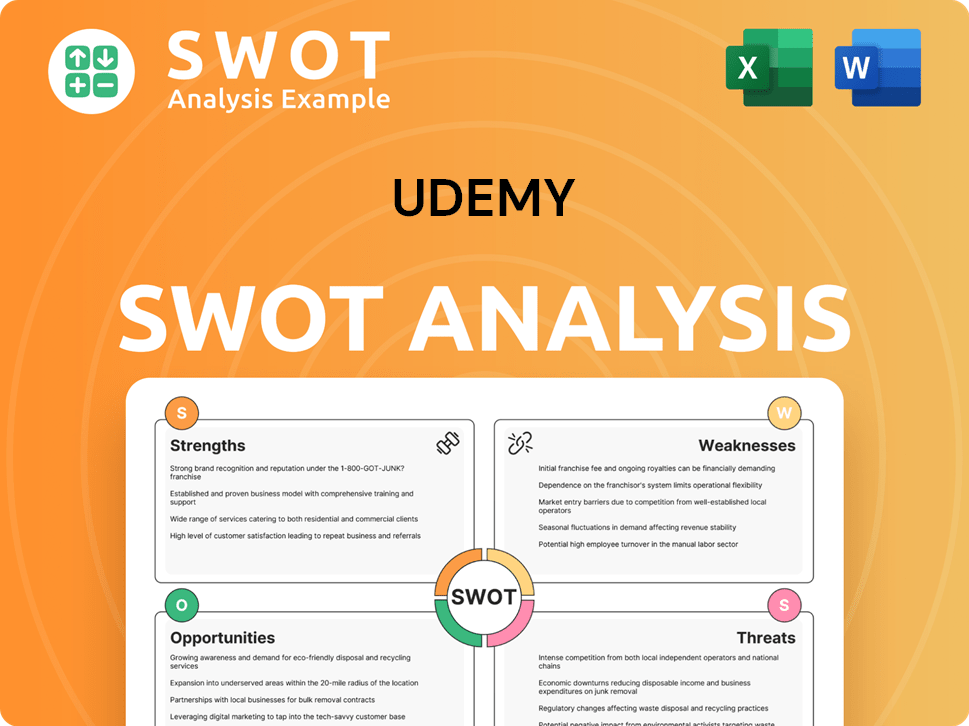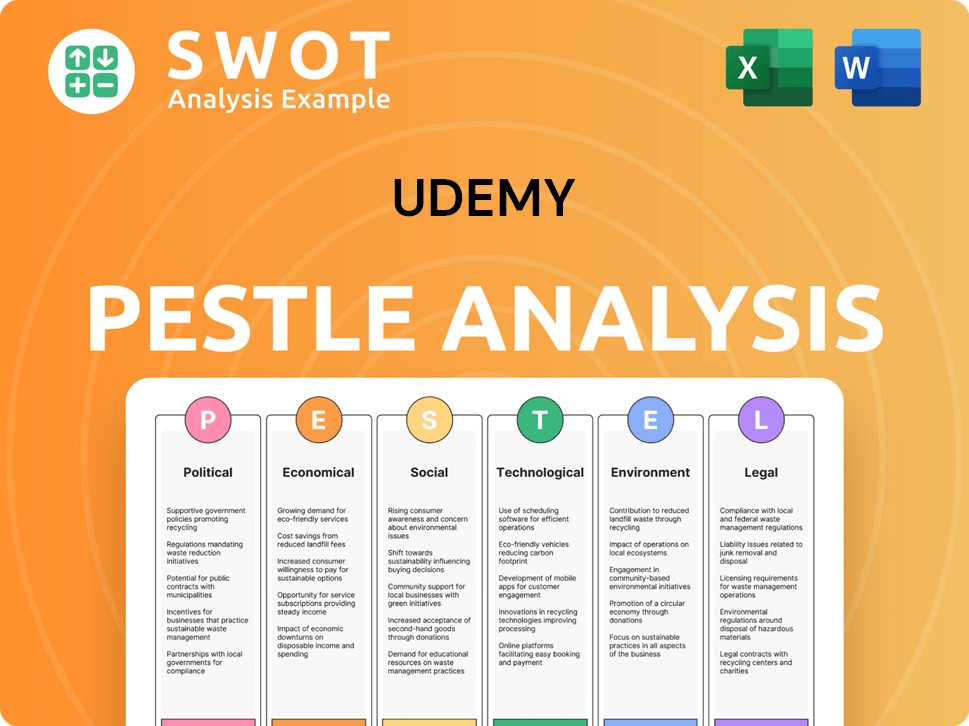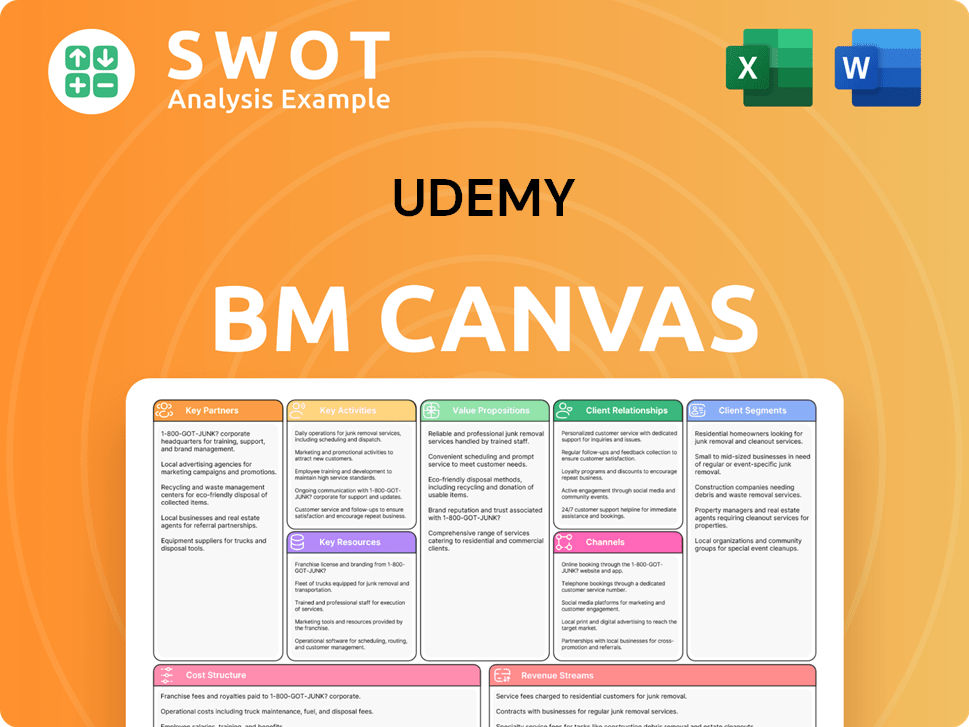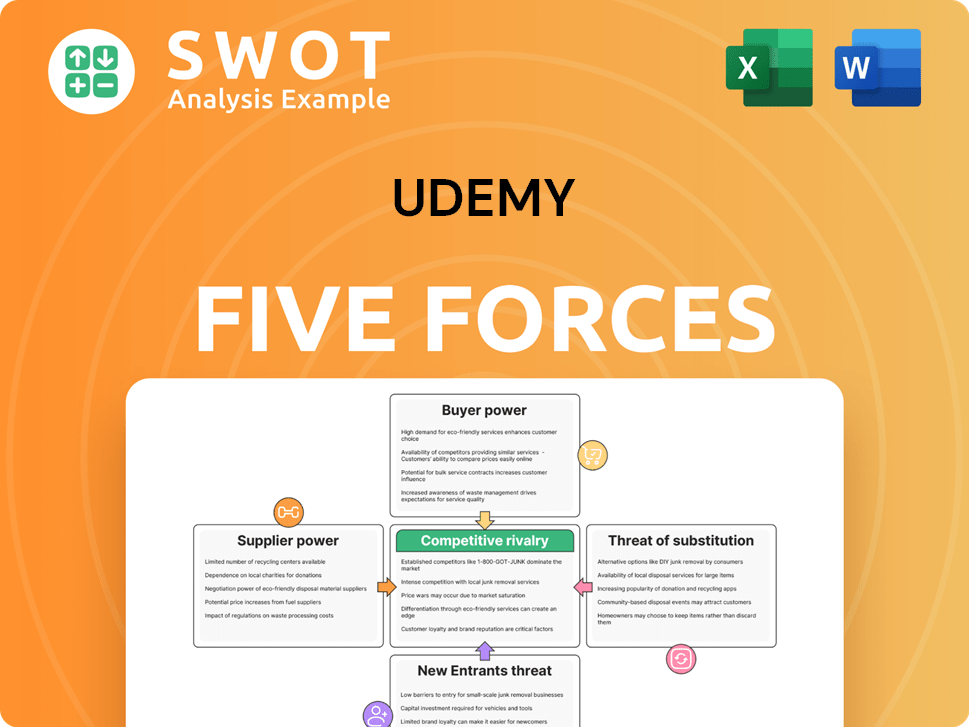Udemy Bundle
How Does Udemy Thrive in the E-Learning Arena?
Udemy, a leading force in the online learning landscape, connects millions of learners with a vast selection of Udemy SWOT Analysis courses. In 2024, the Udemy platform generated $786.6 million in revenue, showcasing its robust growth and market presence. With a strategic pivot towards enterprise solutions, Udemy is adapting to the evolving demands of workforce development, especially with the rise of generative AI.

This exploration into Udemy will dissect its operational framework and revenue strategies, providing crucial insights for investors and stakeholders. We'll examine the Udemy business model explained, its competitive advantages, and future prospects within the dynamic e-learning market. Understanding the Udemy courses ecosystem, including Udemy course pricing and Udemy student reviews, is key to evaluating its long-term potential.
What Are the Key Operations Driving Udemy’s Success?
The core operations of the Udemy platform revolve around connecting instructors with learners in an online learning environment. This course marketplace provides a platform for individuals to create and sell courses, while learners gain access to a vast library of educational content. The platform's value proposition centers on offering accessible, affordable, and flexible self-paced learning across diverse subjects.
Udemy's business model is designed for scalability. Instructors create and host their courses, setting their own prices. This allows Udemy to maintain a large and ever-growing course library without the need to create its own content. This approach has enabled Udemy to become a significant player in the e-learning industry.
The platform operates on a dual-market approach, serving individual learners and businesses. The consumer marketplace provides access to individual Udemy courses, while Udemy Business (UB) offers subscription-based access to curated courses for corporate training. This dual strategy allows Udemy to cater to a broad audience, from individual students to large enterprises seeking to upskill their employees.
Instructors create and upload their courses, setting their own prices. Udemy provides the platform and tools for course creation and hosting. This model allows for a wide variety of courses and subjects.
The platform serves individual learners through its consumer marketplace. It also offers Udemy Business (UB) for corporate training. This dual approach expands the reach and revenue potential.
Udemy invests in technology, such as AI-powered Skills Mapping. This helps personalize learning paths for enterprise customers. Continuous innovation is key to maintaining a competitive edge.
Strategic partnerships expand market reach and access to Udemy Business solutions. Collaborations with companies like Ingram Micro and FPT help broaden the platform's impact. These partnerships are essential for growth.
As of 2024, Udemy had 75,000 instructors and approximately 250,000 courses available in 75 languages, demonstrating its global reach and extensive content library. The platform’s technology development is a key operational area, with recent advancements including AI-powered Skills Mapping, which over 1,800 enterprise customers have leveraged since its launch in November 2024 to create personalized learning paths. The supply chain consists of its network of instructors and content creators, with partnerships playing a vital role in distribution and market expansion, such as the collaboration with Ingram Micro to broaden access to Udemy Business solutions across India, and with FPT to enhance human resource development in Vietnam. To learn more about the company's origins, you can read a brief history of Udemy.
Udemy offers on-demand, relevant learning for individuals and flexible, scalable training for businesses. The platform's crowdsourced content model, combined with its dual-market approach, provides a wide variety of up-to-date skills.
- Accessibility: Affordable and on-demand courses.
- Flexibility: Self-paced learning options.
- Variety: A vast library of courses across many subjects.
- Scalability: Training solutions for businesses of all sizes.
Udemy SWOT Analysis
- Complete SWOT Breakdown
- Fully Customizable
- Editable in Excel & Word
- Professional Formatting
- Investor-Ready Format

How Does Udemy Make Money?
The Udemy platform generates revenue through two primary segments: the Consumer segment and the Enterprise segment (Udemy Business). These segments employ distinct monetization strategies tailored to their respective target audiences. Understanding these approaches provides insight into how Udemy operates and sustains its business.
For the full year 2024, Udemy achieved a total revenue of $786.6 million, marking an 8% year-over-year increase. The Enterprise segment saw substantial growth, contributing $494.5 million, which is a 18% year-over-year increase and represents 63% of total revenue. The Consumer segment generated $292.1 million, though it experienced a 5% year-over-year decline.
The Udemy business model explained involves a multi-faceted approach to revenue generation. The Consumer segment focuses on individual course purchases, utilizing flexible pricing and promotional strategies. The Enterprise segment, known as Udemy Business, operates on a subscription basis, offering curated course libraries and learning management tools to organizations. These diverse strategies enable Udemy to cater to a broad audience in the online learning space.
The Consumer segment primarily earns revenue when individual learners purchase Udemy courses. Instructors set the prices for their courses, and the platform frequently offers discounts and promotions. The Udemy Personal Plan, a subscription model, provides access to a wide array of courses.
- Individual course purchases.
- Subscription model (Udemy Personal Plan).
- Promotional discounts to attract students.
Udemy Business operates on a subscription basis, offering organizations access to a curated course library. Pricing is typically per-seat, with volume discounts available. Contracts are usually annual or multi-year. This segment includes Team, Enterprise, and Pro plans, as well as a Leadership Academy.
- Subscription-based model for organizations.
- Per-seat pricing with volume discounts.
- Annual or multi-year contracts.
- Various plans: Team, Enterprise, Pro, and Leadership Academy.
The instructor revenue share model is a key aspect of Udemy's monetization. Instructors receive a percentage of course sales. In January 2024, the subscription model instructor share adjusted from 25% to 20%, with further reductions planned to 17.5% in January 2025 and 15% in January 2026. The marketplace revenue share (37%) remains unchanged. This strategic shift aims to support investments and business growth. For more context, you can explore the Competitors Landscape of Udemy.
- Instructor revenue share model.
- Subscription model instructor share adjustment: 20% (2024), 17.5% (2025), 15% (2026).
- Marketplace revenue share: 37%.
- Focus on upmarket enterprise customers for sustainable growth.
Udemy PESTLE Analysis
- Covers All 6 PESTLE Categories
- No Research Needed – Save Hours of Work
- Built by Experts, Trusted by Consultants
- Instant Download, Ready to Use
- 100% Editable, Fully Customizable

Which Strategic Decisions Have Shaped Udemy’s Business Model?
The evolution of the Udemy platform has been marked by significant milestones and strategic shifts. A key move has been the focus on serving large enterprise customers, which has driven substantial growth in the Udemy Business segment. This strategic pivot is evident in the financial performance, reflecting a deliberate effort to capture a larger share of the corporate training market.
Operational challenges, such as foreign exchange fluctuations, have influenced Udemy's financial results. The company has also undertaken strategic restructuring to enhance operational efficiency. These moves demonstrate Udemy's efforts to adapt to market conditions and optimize its business model. The company has also been focused on AI-driven learning experiences to address the growing demand for skills development, especially in areas like generative AI.
Udemy's competitive advantages are multifaceted, including its extensive course catalog and technology leadership. The crowdsourced content model and brand strength contribute to its position in the online learning market. The company continues to adapt to new trends and technology shifts, with a strong emphasis on AI-driven learning experiences to address the growing demand for skills development, especially in areas like generative AI.
Udemy Business saw an 18% revenue increase in 2024, reaching $494.5 million. Annual Recurring Revenue (ARR) for Udemy Business grew by 11% to $516.9 million. These figures highlight the success of the enterprise-focused strategy.
By the end of 2024, Udemy had grown its enterprise customer base by 9%, reaching 17,096 customers. This expansion underscores the company's ability to attract and retain large corporate clients. The company is growing its enterprise customer base.
Foreign exchange fluctuations had a 2-percentage-point negative impact on total revenue in 2024. A strategic restructuring plan in September 2024 affected approximately 280 global employees. These moves aimed to improve operational efficiency.
Udemy offers over 250,000 courses in 75 languages. Its crowdsourced content model enables rapid content expansion. Technology leadership, including AI-powered features like Skills Mapping, provides a competitive edge. To understand the Udemy target audience, check out the Target Market of Udemy.
Udemy Business Model Canvas
- Complete 9-Block Business Model Canvas
- Effortlessly Communicate Your Business Strategy
- Investor-Ready BMC Format
- 100% Editable and Customizable
- Clear and Structured Layout

How Is Udemy Positioning Itself for Continued Success?
The Udemy platform holds a prominent position in the online learning market, distinguished by its extensive global reach and a large learner base. As of early 2025, Udemy reported 79 million learners and 17,216 enterprise customers, highlighting its widespread impact. The company is a leading course marketplace, with a significant portion of its revenue generated internationally.
Despite its strong market position, Udemy faces several risks, including intense competition from other e-learning platforms. The company's reliance on a large network of instructors also presents a risk. Furthermore, macroeconomic factors and regulatory changes, especially regarding privacy and data protection, add to the uncertainty.
Udemy is a key player in the online learning sector, with a vast global presence. The Udemy platform serves millions of learners and thousands of enterprise clients. Its international reach is substantial, with a significant percentage of revenue coming from outside North America.
Competition from platforms like Coursera and Skillshare poses a challenge. Reliance on instructors and potential loss of key content creators impacts the platform. Consumer revenue decline and macroeconomic factors also present risks to Udemy courses.
Udemy aims to boost profitability through strategic initiatives. The company projects revenue between $787 million and $803 million in 2025. They are focused on enterprise customer growth and AI-powered learning solutions.
Investing in the enterprise customer base is a key strategy. Udemy plans to enhance course offerings, especially with AI. The company is targeting an adjusted EBITDA between $130 million and $150 million by 2027.
Udemy is working on expanding its enterprise customer base and improving its Udemy courses. The company is also focused on achieving operational efficiencies. For more information on Udemy's growth strategy, you can read the article Growth Strategy of Udemy.
- Focus on enterprise customer growth.
- Enhancing course offerings with AI.
- Aiming for operational efficiencies.
- Targeting long-term profitability goals.
Udemy Porter's Five Forces Analysis
- Covers All 5 Competitive Forces in Detail
- Structured for Consultants, Students, and Founders
- 100% Editable in Microsoft Word & Excel
- Instant Digital Download – Use Immediately
- Compatible with Mac & PC – Fully Unlocked

Related Blogs
- What are Mission Vision & Core Values of Udemy Company?
- What is Competitive Landscape of Udemy Company?
- What is Growth Strategy and Future Prospects of Udemy Company?
- What is Sales and Marketing Strategy of Udemy Company?
- What is Brief History of Udemy Company?
- Who Owns Udemy Company?
- What is Customer Demographics and Target Market of Udemy Company?
Disclaimer
All information, articles, and product details provided on this website are for general informational and educational purposes only. We do not claim any ownership over, nor do we intend to infringe upon, any trademarks, copyrights, logos, brand names, or other intellectual property mentioned or depicted on this site. Such intellectual property remains the property of its respective owners, and any references here are made solely for identification or informational purposes, without implying any affiliation, endorsement, or partnership.
We make no representations or warranties, express or implied, regarding the accuracy, completeness, or suitability of any content or products presented. Nothing on this website should be construed as legal, tax, investment, financial, medical, or other professional advice. In addition, no part of this site—including articles or product references—constitutes a solicitation, recommendation, endorsement, advertisement, or offer to buy or sell any securities, franchises, or other financial instruments, particularly in jurisdictions where such activity would be unlawful.
All content is of a general nature and may not address the specific circumstances of any individual or entity. It is not a substitute for professional advice or services. Any actions you take based on the information provided here are strictly at your own risk. You accept full responsibility for any decisions or outcomes arising from your use of this website and agree to release us from any liability in connection with your use of, or reliance upon, the content or products found herein.